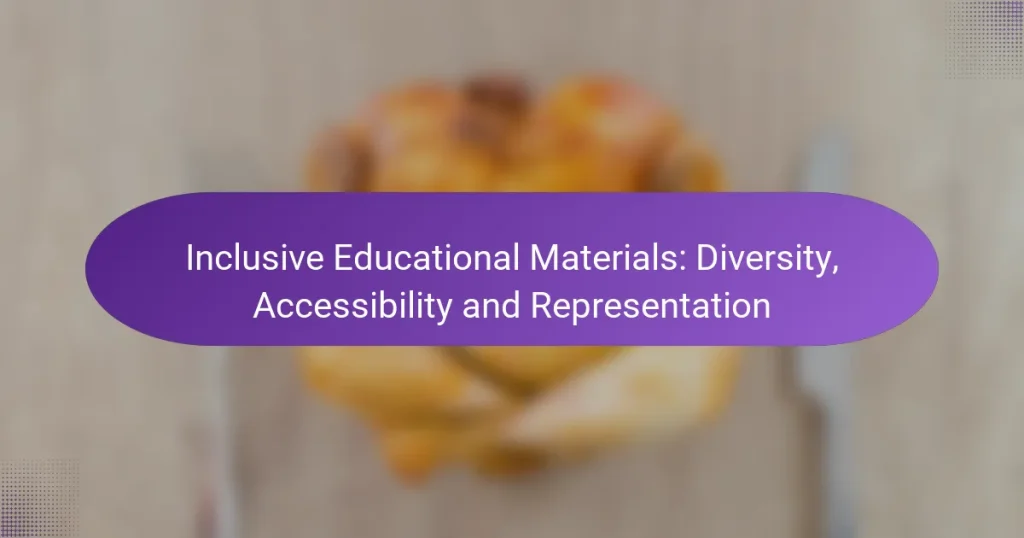Inclusive educational materials are essential for creating equitable learning environments that cater to the diverse needs of all students. By prioritizing accessibility, representation, and cultural relevance, these materials ensure that every learner can engage meaningfully with the content, ultimately enhancing their educational experience. Emphasizing diversity in educational resources not only supports individual learning styles but also fosters a more inclusive and effective classroom atmosphere.
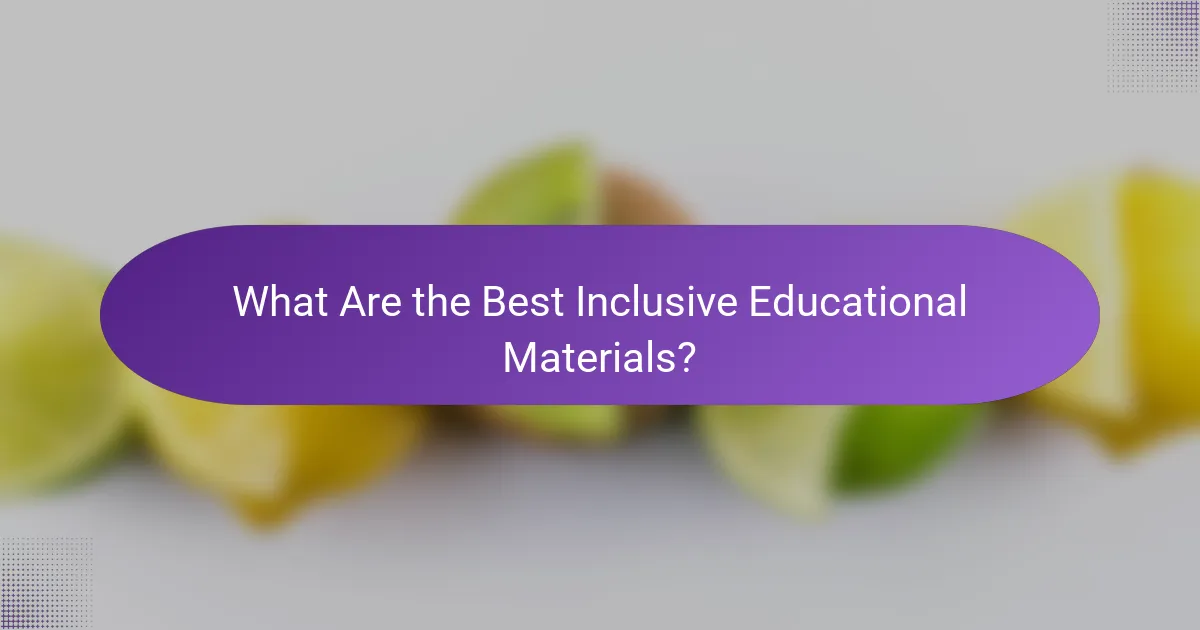
What Are the Best Inclusive Educational Materials?
The best inclusive educational materials are those that cater to diverse learning needs, ensuring accessibility and representation for all students. These materials include a variety of formats and content that reflect different cultures, languages, and abilities, making education equitable and effective.
Diverse Textbooks
Diverse textbooks include content that represents various cultures, perspectives, and experiences. When selecting textbooks, look for those that feature authors from different backgrounds and include stories from a range of communities. This not only enriches the curriculum but also helps students see themselves reflected in their studies.
Consider using textbooks that incorporate multiple viewpoints on historical events or social issues. This approach fosters critical thinking and encourages students to engage with material in a more meaningful way.
Accessible Digital Resources
Accessible digital resources are designed to be usable by all students, including those with disabilities. Look for materials that comply with accessibility standards such as WCAG (Web Content Accessibility Guidelines), ensuring features like text-to-speech, adjustable text sizes, and alternative text for images.
Utilizing platforms that offer customizable learning experiences can enhance accessibility. For instance, resources that allow users to change background colors or fonts can significantly improve readability for students with visual impairments.
Multilingual Learning Tools
Multilingual learning tools support students who speak different languages by providing resources in their native tongues. These tools can include bilingual textbooks, translation apps, and language learning software that facilitate comprehension and engagement.
When selecting multilingual tools, ensure they are culturally relevant and accurately reflect the languages spoken by your student population. This can help bridge language barriers and promote inclusivity in the classroom.
Representation in Literature
Representation in literature is crucial for fostering an inclusive educational environment. Choose books that feature characters from diverse backgrounds and experiences, allowing students to connect with the material on a personal level.
Encourage discussions around these texts to highlight themes of diversity and inclusion. This not only enriches students’ understanding but also promotes empathy and respect for different cultures.
Adaptive Learning Technologies
Adaptive learning technologies personalize the educational experience by adjusting content based on individual student needs. These tools can assess a student’s progress and tailor lessons to address specific gaps in knowledge or skills.
When implementing adaptive technologies, ensure they are user-friendly and provide clear feedback. This can help students stay motivated and engaged, making learning more effective for everyone.
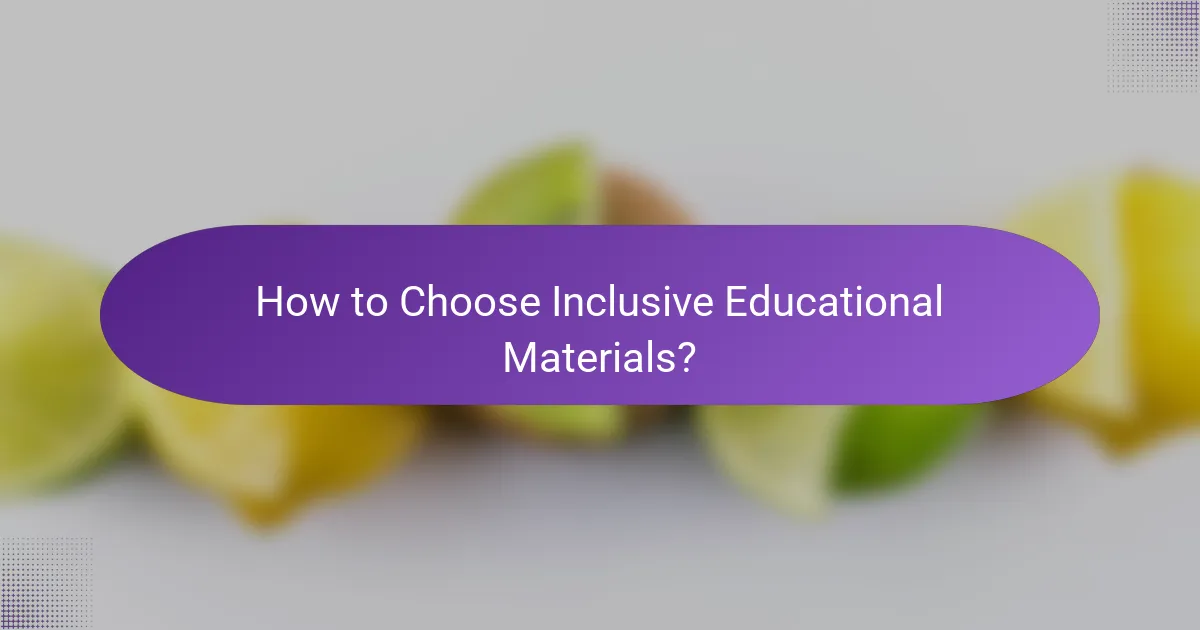
How to Choose Inclusive Educational Materials?
Choosing inclusive educational materials involves evaluating their diversity, accessibility, and cultural relevance. Prioritizing these factors ensures that all learners can engage meaningfully with the content.
Assessing Diversity and Representation
When assessing diversity and representation in educational materials, consider the variety of perspectives and backgrounds included. Look for materials that feature characters and authors from different ethnicities, genders, abilities, and socioeconomic statuses.
A good practice is to check if the materials reflect a balanced representation of various groups. For example, if a textbook predominantly features white male authors, it may lack the diversity necessary for inclusive learning.
Evaluating Accessibility Features
Evaluating accessibility features is crucial for ensuring that all students can access educational materials. Check for compatibility with assistive technologies, such as screen readers, and ensure that text is available in multiple formats, including audio and braille.
Additionally, consider the readability of the materials. Use tools that assess readability scores and ensure that the content is suitable for various learning levels. Avoid overly complex language and provide clear, concise explanations.
Considering Cultural Relevance
Cultural relevance in educational materials means that the content resonates with the experiences and backgrounds of the learners. Materials should reflect the cultural contexts of the students, making the learning experience more relatable and engaging.
To assess cultural relevance, review the examples and scenarios presented in the materials. Ensure they are appropriate and meaningful for the target audience. For instance, using local historical events or familiar cultural references can enhance understanding and connection.

What Are the Benefits of Inclusive Educational Materials?
Inclusive educational materials provide significant advantages by catering to diverse learning needs, enhancing accessibility, and ensuring representation. These benefits lead to improved educational experiences for all students, fostering an environment where everyone can thrive.
Enhanced Learning Outcomes
Inclusive educational materials can lead to better learning outcomes by addressing the varied needs of students. When resources are designed to accommodate different learning styles and abilities, they help all students grasp concepts more effectively. For example, using visual aids alongside text can support both visual and auditory learners.
Research indicates that students exposed to inclusive materials often demonstrate higher retention rates and improved academic performance. This is particularly important in diverse classrooms where students may have different backgrounds and learning challenges.
Increased Engagement
When educational materials reflect the diversity of the student population, engagement levels tend to rise. Students are more likely to connect with content that represents their identities and experiences, which can lead to increased motivation and participation in class activities. For instance, incorporating stories and examples from various cultures can make lessons more relatable.
Teachers can further enhance engagement by incorporating interactive elements, such as group discussions or hands-on projects, that allow students to explore the material in a way that resonates with them. This approach can create a more dynamic and inclusive classroom atmosphere.
Promotion of Equity
Inclusive educational materials promote equity by ensuring that all students have access to the same quality of education. By providing resources that are adaptable to different needs, schools can help level the playing field for students who may otherwise face barriers to learning. This is crucial in meeting the standards set by educational regulations, such as the Individuals with Disabilities Education Act (IDEA) in the United States.
To effectively promote equity, educators should regularly assess the inclusivity of their materials and seek feedback from students. This can involve reviewing lesson plans and resources to ensure they reflect diverse perspectives and are accessible to all learners, regardless of their backgrounds or abilities.

How Do Inclusive Materials Support Diverse Learners?
Inclusive educational materials are designed to meet the varied needs of all learners, ensuring that everyone has equal access to learning opportunities. By considering diversity, accessibility, and representation, these materials foster an environment where every student can thrive.
Accommodating Different Learning Styles
Inclusive materials recognize that students have different learning preferences, such as visual, auditory, and kinesthetic styles. To accommodate these differences, educators can incorporate a mix of multimedia resources, hands-on activities, and collaborative projects that engage various senses.
For example, a lesson on ecosystems might include videos, interactive simulations, and group discussions. This approach not only caters to diverse learning styles but also enhances overall comprehension and retention of information.
Supporting Students with Disabilities
Inclusive educational materials play a critical role in supporting students with disabilities by providing accessible formats and adaptive technologies. This may include text-to-speech software, braille resources, or adjustable font sizes to ensure that all students can engage with the content effectively.
Additionally, it’s essential to follow guidelines such as the Americans with Disabilities Act (ADA) in the U.S. or similar regulations in other countries, which mandate accessibility in educational settings. By proactively addressing these needs, educators can create a more equitable learning environment.
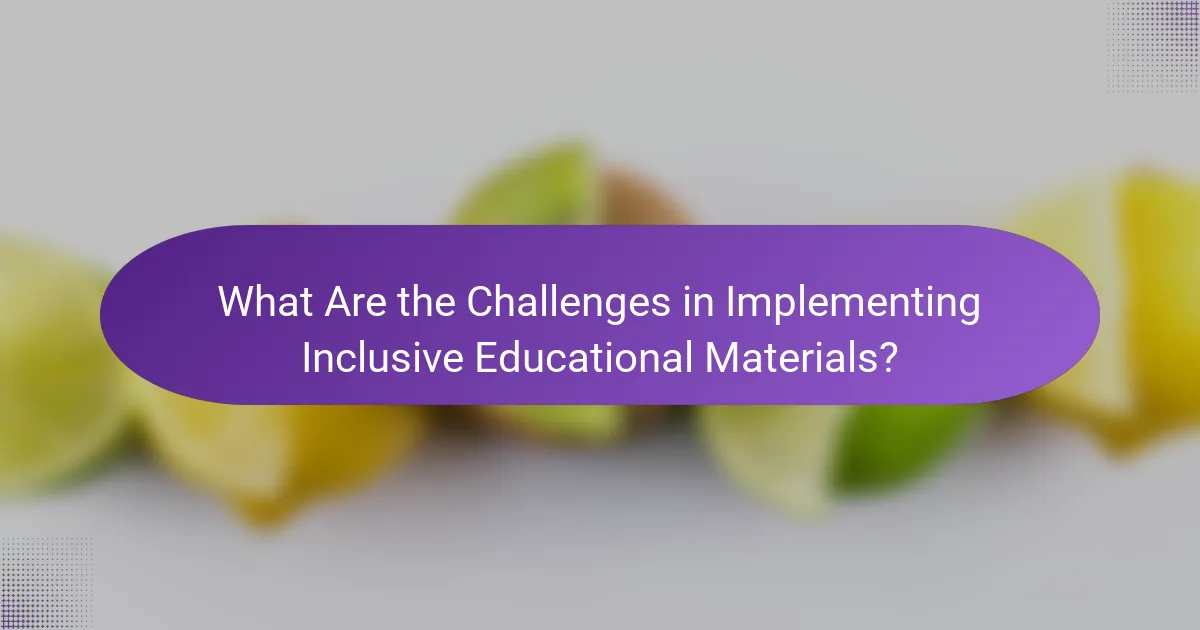
What Are the Challenges in Implementing Inclusive Educational Materials?
Implementing inclusive educational materials faces several challenges, including financial constraints, the need for educator training, and resistance to change within institutions. Addressing these obstacles is crucial for creating a more equitable learning environment.
Cost Considerations
Cost is a significant barrier to implementing inclusive educational materials. Schools and educational institutions often operate on tight budgets, making it difficult to allocate funds for specialized resources or training programs. For example, developing or purchasing materials that cater to diverse learning needs can range from hundreds to thousands of dollars, depending on the scope.
To manage costs effectively, institutions can explore grants, partnerships with non-profits, or community funding initiatives. Additionally, leveraging open educational resources (OER) can provide cost-effective alternatives that still meet inclusivity standards.
Training Educators
Training educators is essential for the successful implementation of inclusive materials. Teachers must understand how to effectively use these resources and adapt their teaching methods to accommodate diverse learners. Professional development programs focused on inclusivity can vary in duration and cost, often requiring ongoing commitment.
Institutions should prioritize regular training sessions and workshops that emphasize practical strategies for inclusivity. Collaborating with experienced educators or specialists can enhance these training programs, ensuring that all staff members are equipped to support diverse student needs.
Resistance to Change
Resistance to change can hinder the adoption of inclusive educational materials. Some educators and administrators may be hesitant to alter established practices or may not fully understand the benefits of inclusivity. This resistance can stem from a lack of awareness or fear of additional workload.
To overcome this challenge, it is vital to foster a culture of openness and collaboration. Highlighting success stories and demonstrating the positive impact of inclusive practices on student outcomes can help shift mindsets. Engaging stakeholders in discussions and decision-making processes can also reduce resistance and encourage a collective commitment to inclusivity.
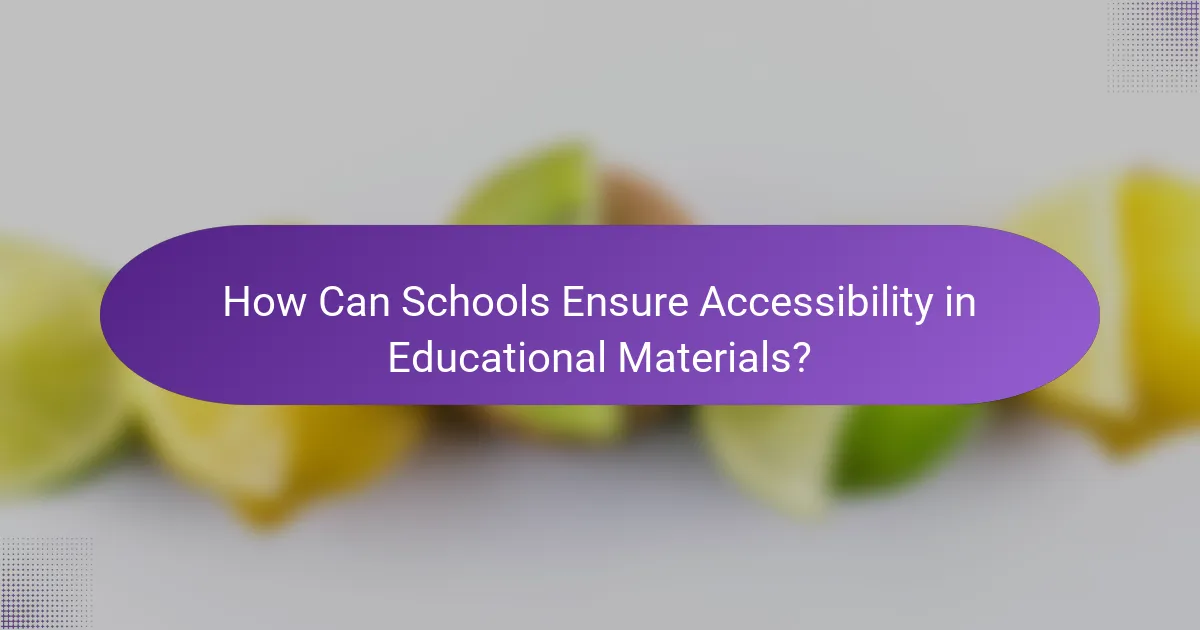
How Can Schools Ensure Accessibility in Educational Materials?
Schools can ensure accessibility in educational materials by implementing inclusive practices that cater to diverse learning needs. This involves creating resources that are usable by all students, regardless of their abilities or backgrounds.
Adopting Universal Design Principles
Universal Design Principles focus on creating educational materials that are accessible to everyone from the outset. This includes using clear language, providing multiple means of representation, and ensuring that materials are compatible with assistive technologies.
For example, digital content should be designed to be navigable by screen readers and should include captions for videos. Schools can also consider using color contrast and font size adjustments to enhance readability for students with visual impairments.
Regular Accessibility Audits
Conducting regular accessibility audits helps schools identify barriers in their educational materials and practices. These audits should evaluate both physical resources and digital content to ensure compliance with accessibility standards.
Schools can create a checklist for these audits, focusing on areas such as website accessibility, availability of alternative formats, and the physical layout of classrooms. Engaging students and staff in the audit process can provide valuable insights into specific needs and improvements.
